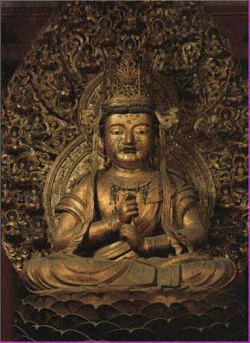The Hanmi Lineage
Hanmi Chinese Esoteric School of Buddhism
The Hanmi lineage has its origins in the spiritual teachings and practices of ancient India that were developed by the Brahmans, and were then evolved and transmitted by the great saint Shakyamuni Buddha over 2,400 years ago.
Disciples of Nagarjuna brought the Buddhist teachings from Nalanda monastery in India to Xi’an city in China around 1,300 years ago, and combined them with Taoism and Confucianism.
The awakened masters have preserved this knowledge through an unbroken lineage in the Hanmi Chinese Esoteric School of Buddhism. The current lineage bearer is Living Buddha Dechan Jueren, otherwise known as Master Yu.
Hanmi Buddhism was established between 712 to 720 A.D. during the reign of emperor Tang Xuanzong (or Hsuan Tsung) by the Three Great Founders, Subhakarasimha, Vajrabodhi, and Amoghavajra. They came to the Daxing Shansi (Great Propagating Goodness Temple) in today’s Xi’an City and translated many Buddhist sutras and tantras from Sanskrit to Chinese. Assimilating the prevailing teaching of Confucianism and Taoism, they evolved the teaching into Hanmi, which was more easily understood by the Chinese people.
Subhakarasimha, an eminent Indian monk, translated the Vairocanabhi-sambodhi-tantra, or the Mahavairocana Sutra from Sanskrit to Chinese.
Vajrabodhi, a graduate of Nalanda Temple, received complete empowerment and transmission from Nagabodhi, who received from Nagarjuna.
Amoghavajra, a Singhalese, came at the age of 15 to China, where in 718 he became a disciple of Vajrabodhi, and later of Subhakarasimha. The Tang emperor granted dharma instruments to Amoghavajra who set up the first abhiseka-bodhi-mandala at Daxing Temple, thus founding Hanmi.
After Vajrabodhi’s death in 732, and at his wish, Amoghavajra went to India and Ceylon in search of esoteric or tantric writings, and returned in 746, when he baptized the emperor Xuanzong. He was especially noted for rain-making and stilling storms. In 749 he received permission to return home, but was stopped by imperial orders when in the south of China.
In 756 under emperor Suzong he was recalled to the capital. His time until 771 was spent translating and editing tantric books in 120 volumes, and the Yogachara rose to his peak of prosperity. He died greatly honored at 70 years of age, in 774, the twelfth year of Taizong, the third emperor under whom he had served. He was given the title of the Thesaurus of Wisdom, Amogha Tripikata and the posthumous rank and title of a Minister of State.
Historically, the Hanmi Chinese Esoteric School of Buddhism was thought to have been lost when Emperor Tang Wuzong banned the teaching. Huiguo, the last known disciple of Amoghavajra, left China and had gone with Kukai to Japan to establish the Japanese Esoteric school of Buddhism, later known as Shingon. Unknown to history, Amoghavajra had another disciple, Huisu, who received all the religious instruments and dharma transmission. He then became the Dharma Lineage Bearer. Since then, Hanmi has been underground for over twelve centuries, and has been passed on through one master per generation.
Master Yu was the highest and only master of Hanmi, was the Honorable Abbot of the 1,000-year old LongQuan Temple in Chifeng, Inner Mongolia, was a doctor of Chinese medicine, and was acknowledged as a Living Buddha in China.
Master Yu, from Chaoyang, Liaoning, at the age of 39, attained realization under the guidance of Grandmaster Huiling, the 48th Maha-Acharya of the Hanmi lineage. Master Yu saw the past, the present and the future, and understood his mission as a Hanmi successor. He resigned his position as a plant manager in China, and donated all his personal savings, over 1 million RMB, to the cause of reviving Buddha-dharma. He said,”I want to let people know the truth of Buddhism again.” He experienced all kinds of hardship as he journeyed through great rivers and mountains in order to transmit Dharma and to heal people. He has left indelible impressions everywhere.
In 1989, a discovery was made in the Heaven Chamber of the North Pagoda at Chaoyang City, Liaoning Province. They found sharira, or the bone relic of the Buddha, sutra and tantra engraved in silver plates in Chinese, two Chinese Stupas of the Diamond and the Womb Worlds, and the Stupa of Five-Buddha-Five-Wisdom. Later, a Hanmi mandala was also discovered in the Earth Chamber of Famen Temple (Famensi), or Dharma Doorway Temple at Fufeng County, Shaanxi Province. These discoveries predict the revival of Hanmi Buddhism.
Master Huiling found Master Yu on the 99th day after the discovery. Master Yu received complete empowerment and transmission, and became the Great Enlightener MahaVairocana Dharma King Dechan Jueren, the 49th Great Acharya and lineage bearer of the Hanmi Chinese Esoteric School of Buddhism.
